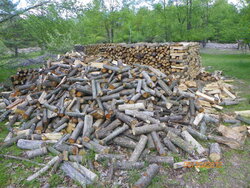Ashful
Minister of Fire
I've had BW that took over two years to dry. It was stacked in multiple rows in the shade. I only stack single rows now with anything. Believe the moisture meter. It is definitely the more accurate than hand weight or the bang test, but don't forget ignorance is bliss.
Apparently ignorance is bliss. The problem with the moisture meter is that it's not actually measuring moisture. It's measuring conductivity. The conductivity of wood relative to its moisture content is dependent on the actual species of wood. Unless your moisture meter allows you to select the species you're measuring, it's not all that accurate a measure of true moisture content. Some meters do a better job than others, allowing you to select two or three ranges of conductivities, and come supplied with a chart telling you which range to use for various species, but even this has somewhat limited accuracy. Any meter with a single range for all species is going to give pretty rough readings.


